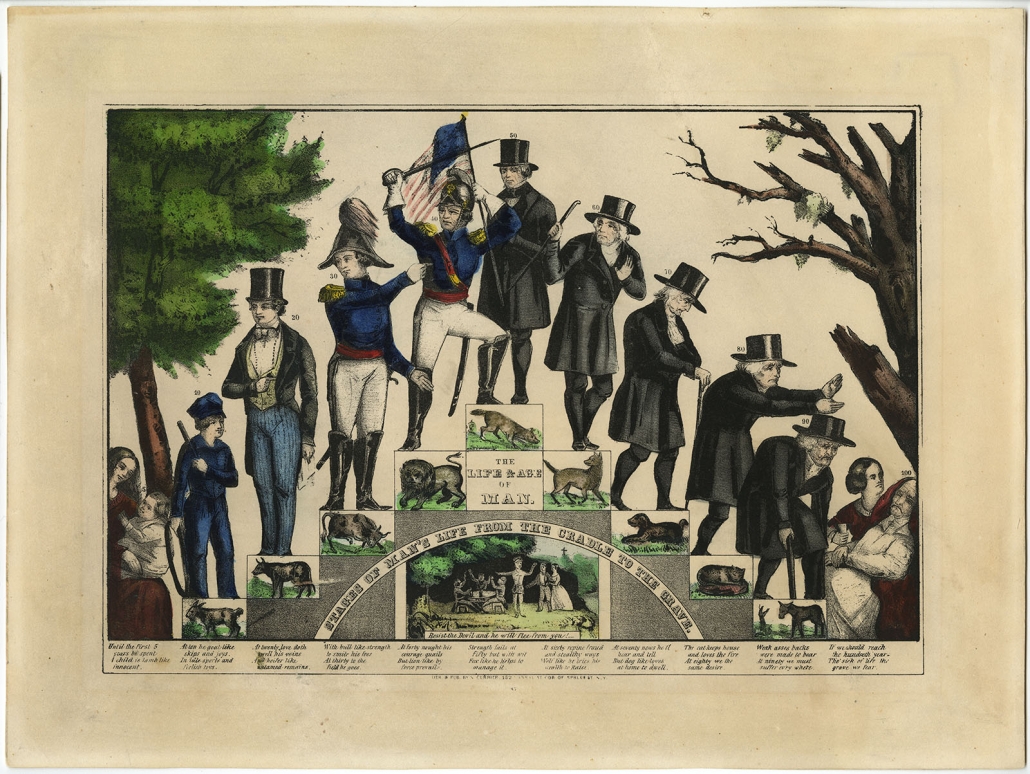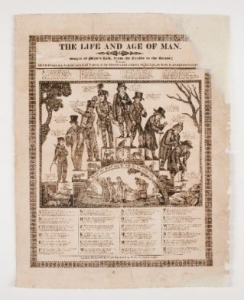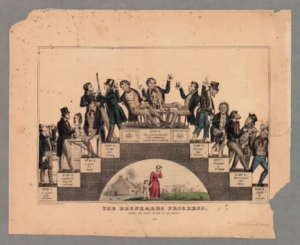Life & Age of Man. Stages of Man’s Life from the Cradle to the Grave. – Lauren B. Hewes
Lauren B. Hewes, Vice President for Collections and Andrew W. Mellon Curator of Graphic Arts, American Antiquarian Society

Examined only digital image.
Nathaniel Currier (1813-1888).
Life & Age of Man. Stages of Man’s Life from the Cradle to the Grave.
New York, ca. 1847.
Hand-colored lithograph.
*GC – Allegories [P.2004.14.1]
Nathaniel Currier apprenticed as a printer in a lithography shop when he was 15, less than a decade after the 1819 invention of the lithographic process. By age 23 he had opened his own printing enterprise in New York. Eventually he would partner with James M. Ives (1824-1895) to create one of the nation’s best-known firms, Currier & Ives, publishing tens of thousands of affordable lithographs for nationwide consumption. But in the early 1840s, Currier was still on his own, trying to grow his profits by producing lithographs for the resale market. He advertised bulk sales to peddlers and travelling agents of 200 prints, including religious and moral subjects.[1] This allegorical scene illustrating the stages of a man’s life could have been among them.
As he was establishing his business, Currier printed reliable moneymakers, including portraits of American presidents, images of battles and marine disasters, and moral prints such as the Life & Age of Man. Like many publishers, Currier frequently copied designs by other artists to keep his stock fresh without having to shoulder the risk of creating a unique (and possibly unpopular) design – a common practice among printers that he would have observed during his apprenticeship.
Prints depicting the phases of human life have a long visual history starting in Renaissance Germany, and the tradition came to America with European immigrants.[2] “Stages of life” broadsides made in Pennsylvania and Massachusetts in the 1820s and 1830s borrowed elements from European versions such as the assignment of animals – a bull for the 30s and a cat for the 80s – and the inclusion of lines of poetry (fig. 1). These appear again on Currier’s 1840s lithograph, although he updated the costumes and offered his print with eye-catching hand-coloring.
It worked. Versions of Life & Age of Man appear in the firm’s catalogs for decades along with a companion piece Life & Age of Woman, and similar titles like The Seven Stages of Matrimony and the Drunkard’s Progress: From the First Glass to the Grave (fig. 2).[3] This staying power, while indicative of continued demand for “stages of life” prints by consumers, can also be viewed as representative of Nathaniel Currier’s understanding of his market – his model of selling cheap popular prints for the masses remained successful for over fifty years.
Keywords:
Allegory / Allegories
Nathaniel Currier
Stages of Life
Illustrations
Fig. 1. The Life and Age of Man. Carlisle, Pennsylvania: Moser & Peters, 1826. American Antiquarian Society.
Fig. 2. The Drunkard’s Progress: From the First Glass to the Grave. New York: Nathaniel Currier, 1846. Hand-colored lithograph. Gift of Charles Henry Taylor. American Antiquarian Society.
[1] New York Journal of Commerce (April 29, 1842): 4. His stock consisted of “about 200 designs among which are a great number of National, Temperance, Moral and Religious subjects.” The number in the lower margin of this print indicates that Life & Age of Man was assigned stock number #87.
[2] See Thomas R. Cole, The Journey of Life: A Cultural History of Aging in America (Cambridge & New York: Cambridge University Press, 1992). Also Julie Melby, “Resist the Devil and He Will Fly Far From You.” Princeton University Library, Graphic Arts Blog, April 2011.
[3] Currier & Ives: A Catalogue Raisonné (Detroit: Gale Research, 1983): 401-2.


